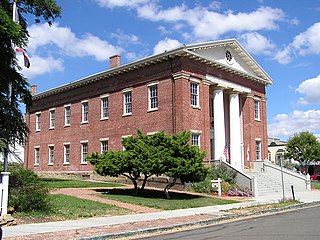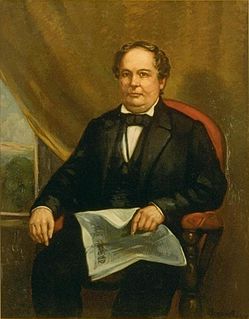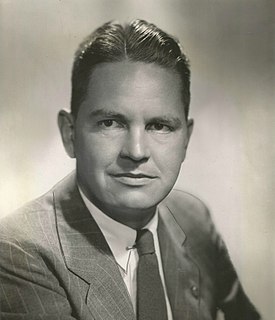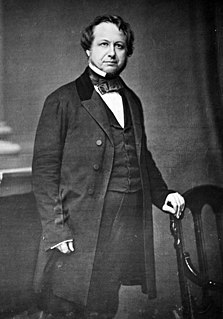
William Freame Johnston was the 11th Governor of Pennsylvania from 1848 to 1852. A lawyer by training, Johnston became district attorney of Westmoreland County at the age of 21 in 1829. He was elected to the Pennsylvania state legislature and switched from the Democratic Party to the Whig Party in 1847 to run for the Pennsylvania Senate.

Benicia Capitol State Historic Park is a state park in Benicia, California. The park is dedicated to California’s third capitol building, where the California State Legislature convened from February 3, 1853 to February 24, 1854, when they voted to move the state capital to Sacramento. It is the only pre-Sacramento capitol that survives. The park includes the Fischer-Hanlon House, an early Benicia building that was moved to the property and converted into a home in 1858, after the legislature departed. Benicia Capitol State Historic Park just off the city's main street also includes a carriage house, workers' quarters and sculptured gardens.

John Bigler was an American lawyer, politician and diplomat. A Democrat, he served as the third governor of California from 1852 to 1856 and was the first California governor to complete an entire term in office, as well as the first to win re-election. His younger brother, William Bigler, was elected governor of Pennsylvania during the same period. Bigler was also appointed by President James Buchanan as the U.S. Minister to Chile from 1857 to 1861.

There have been 90 gubernatorial elections in the state of New York since 1777. The next one will be held on November 3, 2022.

Horatio Seymour was an American politician. He served as Governor of New York from 1853 to 1854 and from 1863 to 1864. He was the Democratic Party nominee for president in the 1868 presidential election.

The Act of Consolidation, more formally known as the act of February 2, 1854, is legislation of the Pennsylvania General Assembly that created the consolidated City and County of Philadelphia, expanding the city's territory to the entirety of Philadelphia County and dissolving the other municipal authorities in the county. The law was enacted by the General Assembly and approved February 2, 1854, by Governor William Bigler. This act consolidated all remaining townships, districts, and boroughs within the County of Philadelphia, dissolving their governmental structures and bringing all municipal authority within the county under the auspices of the Philadelphia government. Additionally, any unincorporated areas were included in the consolidation. The consolidation was drafted to help combat lawlessness that the many local governments could not handle separately and to bring in much-needed tax revenue for the city.

The Vermont Republican Party is the affiliate of the United States Republican Party in Vermont. Deb Billado serves as Chairperson of the Vermont Republican State Committee.

The 1854 New York state election was held on November 7, 1854, to elect the Governor, the Lieutenant Governor, a Canal Commissioner and an Inspector of State Prisons, as well as all members of the New York State Assembly.
All except those in italics won the general election and were elected Governor of California.
The United States Senate elections of 1856 and 1857 were elections which had the young Republican Party assume its position as one of the United States's two main political parties. The Whigs and Free Soilers were gone by the time the next Congress began.
The United States Senate elections of 1860 and 1861 were elections corresponding with Abraham Lincoln's election to the presidency. The nascent Republican Party increased their Senate seats in the general elections, and after southern Democrats withdrew to join the Confederacy, Republicans gained control of the United States Senate. To establish a quorum with fewer members, a lower total seat number was taken into account.

The 1946 Massachusetts gubernatorial election was held on November 5, 1946. Republican Robert F. Bradford defeated Democratic incumbent Maurice J. Tobin, Socialist Labor candidate Horace Hillis, and Prohibition candidate Guy S. Williams.

The Pennsylvania gubernatorial election of 1851 occurred on November 4, 1851. Incumbent governor William F. Johnston, a Whig, was a candidate for re-election but was defeated by Democratic candidate William Bigler.

The 1856 United States Senate election in Pennsylvania was held on January 14, 1856. William Bigler was elected by the Pennsylvania General Assembly to the United States Senate.

The Vermont gubernatorial election of 1928 took place on November 6, 1928. Incumbent Republican John E. Weeks ran successfully for re-election to a second term as Governor of Vermont, defeating Democratic candidate Harry C. Shurtleff. Weeks, who sought an exception to the Vermont Republican Party's "Mountain Rule", was the first Vermont Governor elected to a second two-year term.
Joseph Mansfield was an American newspaper reporter, editor, and publisher.

The 1855 California gubernatorial election was held on September 5, 1855 to elect the governor of California. Incumbent governor John Bigler lost his bid for reelection.

The 1853 California gubernatorial election was held on September 7, 1853 to elect the governor of California. Incumbent governor John Bigler successfully ran for reelection, winning over Whig nominee William Waldo in a close race.

The 1851 California gubernatorial election was held on September 3, 1851 to elect the governor of California.















